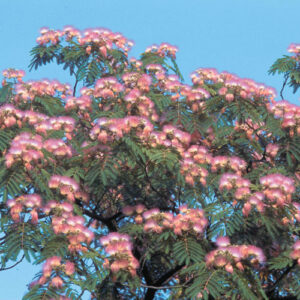
You know the saying: One person’s weed is another person’s wildflower. I suppose the same can be said of trees. There are some species I consider less than desirable, but I’ve never thought of mimosa trees as anything but wonderful. Perhaps it’s because they bloom in summer, when most other trees have long finished flowering. Their fragrant pale pink powderpuff blooms are a welcome break in the monotony of July-green leaves.
Or perhaps it’s the memories that make them wonderful.
I travelled the backroads between central Kentucky and middle Tennessee a couple of weeks ago with daughter Meg and was surprised at her reaction to the hundreds of mimosas we saw dotting the woods. Though born and raised right here in the greenest state in the land of the free, Meg has lived on the high plains of Colorado for more than a decade. Trees there are few are far between.
“Everything’s so lush!!!” she exclaimed as we made our way along the hills and curves of Highway 127 near the Wolf Creek Dam. And then she asked about the trees with the pink flowers.
“They’re mimosas,” I told her. “One of my favorite trees in the whole wide world.”
Obviously, it was time to regale her with a story from my childhood, this one set in the early 1960s in Little Rock, Arkansas. On hot summer Saturdays, my grandparents rarely missed the chance to take my brother Rusty and me fishing at a lake not far from their house. The lake was too small for a john boat but plenty big enough to hold vast numbers of bream, many of which were eager to swallow the red wigglers dancing on the hooks of our cane poles.
Catching the bream was the fun part. Cleaning them, not so much. Grandmother would cover the rickety old picnic table under the huge mimosa tree in her back yard with several layers of The Arkansas Gazette. Then she and Granddaddy, armed with sharp knives, would cut off the fish heads and toss them into a bucket, along with the guts. Rusty’s and my job was to scrape off the scales with the edge of a spoon. It was slimy, smelly, nasty work and we seldom kept at it for long.
The mimosa tree was calling to us. Though not big around, its trunk was smooth and sturdy. Its branches were spaced just right for climbing. For a while, we’d hang by our knees from a low branch. When we grew tired of that, we’d make our way to the top of the tree to survey our kingdom. Back on the ground, we’d snap off leaf stems and run our fingers along them to strip off the fern-like leaves, which we’d pile in mounds on the picnic table near the fish slime. We’d stuff every juice glass Grandmother owned with squatty bouquets of pink puffballs that looked exactly like exploding fireworks.
And we’d agree that there was nothing more wonderful than a mimosa tree.
I know now that we were wrong. Mimosas are trash trees, experts say. Native to China, they were brought to America in 1785 and were popular for many decades, prized not only for the flowers that attracted butterflies and hummingbirds, but because they grew quickly and reproduced easily. That turned out to be part of the problem. These prolific trees–now officially classified as invasive—often grow horribly out of control and steal sunlight, water and soil nutrients from native vegetation. “Don’t plant mimosas!” botanists warn.
So I don’t and I won’t. But sometimes, in summer, I’ll go hunting for a big old mimosa tree. Though I’m too creaky now to climb to the top or to hang by my knees from a sturdy low branch, I can still unfold a lawn chair and sit in the tree’s blessed shade, smelling the pink flowers and stripping fern-like leaves off their stems and remembering.
(July 16, 2022)